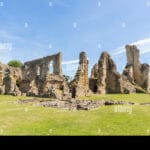Tucked away on the English-Scottish border, Norham offers a tranquil escape steeped in history. Imagine a grand castle overlooking the River Tweed, gentle hills, and a palpable sense of the past. Explore centuries-old stories and soak in the beauty of this Northumberland gem. Whether you’re drawn to the dramatic history of Norham Castle, the charm of village life, or the tranquil walks along the Tweed, this quiet corner of England offers something for everyone.
Norham: Where England Meets Scotland
Nestled along the River Tweed, Norham is a living storybook where Northumberland’s rugged beauty merges with the rolling Scottish hills. It’s a borderland where history is etched into the very stones, a place where whispers of the past intermingle with the river’s murmur. Uncover centuries of secrets, one cobblestone at a time.
Norham Castle: A Border Fortress
Overlooking the village, Norham Castle stands as a proud sentinel, a testament to border conflicts and power struggles. Built in the 12th century, this majestic fortress played a pivotal role in shaping regional history. Ascend the worn stone steps, imagine the echoes of battles, and feel the presence of kings and warriors who once walked these ramparts. The breathtaking panorama of the Tweed Valley from the castle heights is worth the journey.
St. Cuthbert’s Church: A Sanctuary’s History
A short stroll from the castle lies St. Cuthbert’s Church, a sanctuary with architectural echoes of Durham Cathedral. While the current structure dates to the 12th century, the site probably holds older secrets, suggesting a long history of faith. Step inside and feel the weight of centuries of prayer. Legend suggests St. Cuthbert himself sought refuge within these walls, adding intrigue to this hallowed space.
Village Life: Tranquility and Charm
Beyond its historical landmarks, Norham offers respite from modern life. Stroll through the village, past charming cottages, and experience the genuine sense of community. Time seems to slow down here. Duck into one of the village’s cozy pubs, each with unique character and stories. Settle in by the fire with a pint of local ale, and imagine the conversations and laughter that have filled these rooms over the years.
The River Tweed: Nature’s Border
The River Tweed, Norham’s lifeblood, is more than just a geographical feature; it’s a natural border shaping the village’s identity. Renowned for salmon fishing, the Tweed offers anglers a chance to cast a line into its crystal-clear waters. A leisurely stroll along the riverbanks, accompanied by birdsong, provides a tranquil escape. Connect with nature and let the river’s flow wash away stress.
Exploring the Borderlands
Norham is an ideal base for wider exploration. Nearby lies the historic battlefield of Flodden Field, where a pivotal battle between English and Scottish forces unfolded. Venture further into Northumberland National Park, a vast wilderness with rugged hills and hidden valleys waiting to be explored. For coastal adventures and maritime history, consider venturing to Pendennis Point or journey back in time at the magnificent ruins of Moreton Corbet Castle.
Planning Your Norham Escape
| Topic | Details |
|---|---|
| Getting There | Easily accessible by car or bus from Berwick-upon-Tweed. Train connections to Berwick provide convenient access. |
| Accommodation | Charming bed and breakfasts and guesthouses cater to various budgets. Booking in advance is recommended. |
| Dining | Local pubs offer hearty meals and regional specialties in a welcoming atmosphere. |
| Activities | Fishing, walking, cycling, exploring historical sites, and local events. Check local listings. |
Norham is more than just a destination; it’s an experience where history, nature, and village life intertwine. Disconnect from the everyday and reconnect with something deeper. Discover the magic of Norham.
Is Norham in England or Scotland?
Norham is definitively in England, nestled in Northumberland. The River Tweed traces its northern border with Scotland. This proximity likely sparks the question of its nationality.
A Borderland Story
Norham’s story is intertwined with Anglo-Scottish border history, a tale of two nations woven together by the dividing river. The Tweed, flowing peacefully now, bears witness to centuries of conflict and shifting loyalties.
Norham Castle: Between Two Kingdoms
Norham Castle, overlooking the Tweed, symbolizes this shared history. Built from the 12th century, it was a crucial defense against Scottish raids. Its strategic importance made it a hotly contested prize. The castle walls likely absorbed the sounds of countless battles.
More Than a Fortress
Norham Castle also symbolizes the complex Anglo-Scottish relationship. Was it a symbol of oppression or protection? Probably both, depending on your perspective. Today, it’s a reminder of a shared, often turbulent, past.
From Ubbanford to Norham
Before the castle, Norham was Ubbanford. In the 9th century, Ecgred of Lindisfarne established a stone church, replacing an earlier structure. He brought the relics of St. Ceolwulf, giving the site religious importance. Some suggest St. Cuthbert sought refuge there. Could Ubbanford have been central to the Lindisfarne diocese? These glimpses into the past enrich Norham’s history.
From Durham to Northumberland
In 1844, Norham’s administration shifted from County Durham’s Norhamshire exclave to Northumberland. This didn’t alter Norham’s English identity. It simply rearranged its administrative affiliation.
Norham Today
Today, Norham offers a peaceful retreat where history and nature blend. While firmly English, whispers of Scottish history resonate, adding to the village’s unique character.
So, Norham is unequivocally English, but its story is inextricably linked to Scotland, creating a blend of cultures and histories.
What Does the Name Norham Mean?
The meaning of “Norham” remains a puzzle. The most probable explanation lies in Old English roots, its original meaning obscured by time. Before Norham, it was Ubbanford, adding to the intrigue. Researching places ending in “-ham” or “-ford” might offer clues. Did “ham” denote a settlement type, or “ford” a river crossing?
Norham’s location on the Tweed shaped its history, a village in a tug-of-war between two nations. Strangely, Norham was part of County Durham until 1844. What were the reasons for this and its eventual shift to Northumberland?
Norham Castle, a 12th-century fortress, dominates the skyline. What secrets do its walls hold? Nearby, St. Cuthbert’s Church, also 12th century, is sometimes called the “cathedral of the north.” Why? Was it its architecture, size, or association with St. Cuthbert?
The Ordnance Survey Name Books offer glimpses into Norham’s past, documenting changing boundaries. They record the border along the Tweed as “13 miles and 50 chains.” Further exploration of nearby village etymologies like Twizel and Shoreswood might prove fruitful. Local historical societies likely hold further clues. Researching Norham’s history offers a journey of discovery.
How Old is Norham Castle?
Norham Castle, a time capsule of nearly a thousand years of history, stands on the border of England and Scotland.
A Fortress’s Beginnings
In 1121, Bishop Ranulf Flambard built a stronghold on the Scottish border, likely envisioning it as a defense against raids. He probably didn’t foresee its crucial role in the Anglo-Scottish power struggles.
Echoes of Conflict
In 1136 and 1138, King David I’s Scottish forces captured Norham Castle. The castle was reclaimed and fortified, but the 13th and 14th centuries saw repeated Scottish sieges.
Beyond Battles
In 1209, Norham Castle hosted a meeting between King John of England and William the Lion of Scotland. During the Wars of the Roses, it served as a Lancastrian stronghold in 1462. In 1513, James IV of Scotland besieged the castle, capturing its outer ward. Norham and its surrounding area were considered part of County Durham until 1844, illustrating its connection to the Bishopric of Durham.
A Living Testament
Today, Norham Castle, a Grade I listed building and Scheduled Ancient Monument cared for by English Heritage, stands as a living testament to the past. When you visit, you connect with generations past. Every stone whispers a story. Norham Castle’s age isn’t just a date; it’s the weight of centuries.
- Unlocking Francis Alexander Shields’ Finance Empire: A Comprehensive Biography - July 12, 2025
- Unveiling Francis Alexander Shields: A Business Legacy - July 12, 2025
- Francis Alexander Shields’ Business Career: A Comprehensive Overview - July 12, 2025















